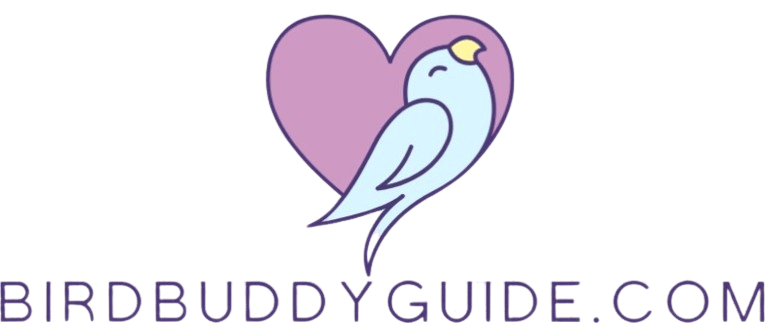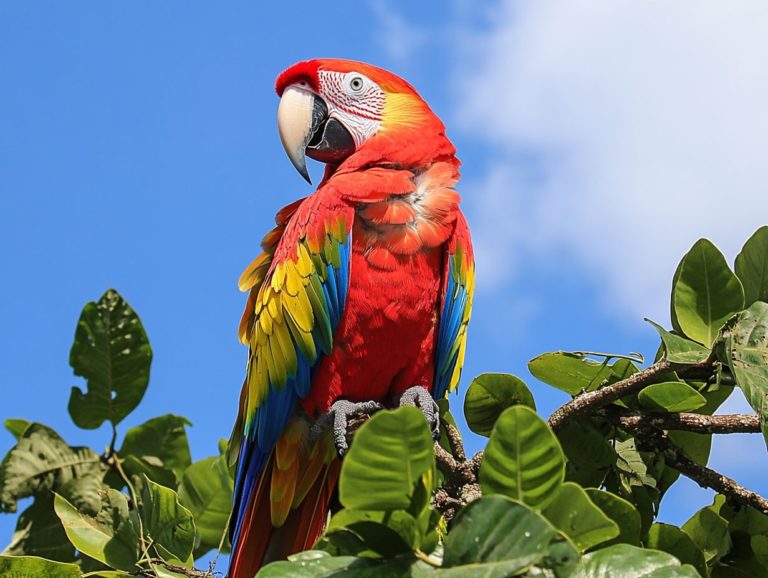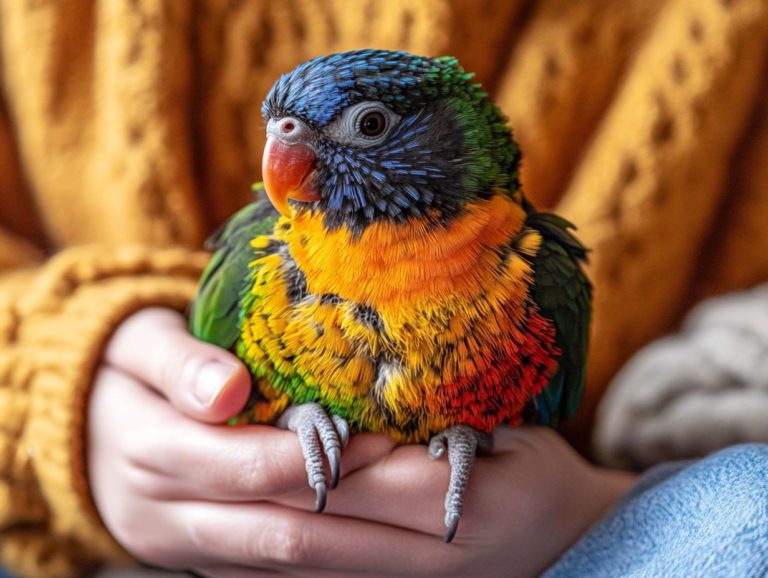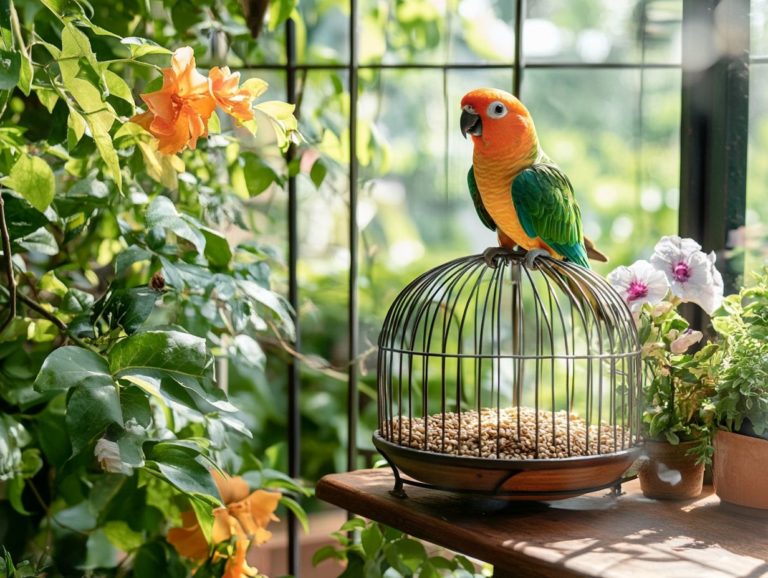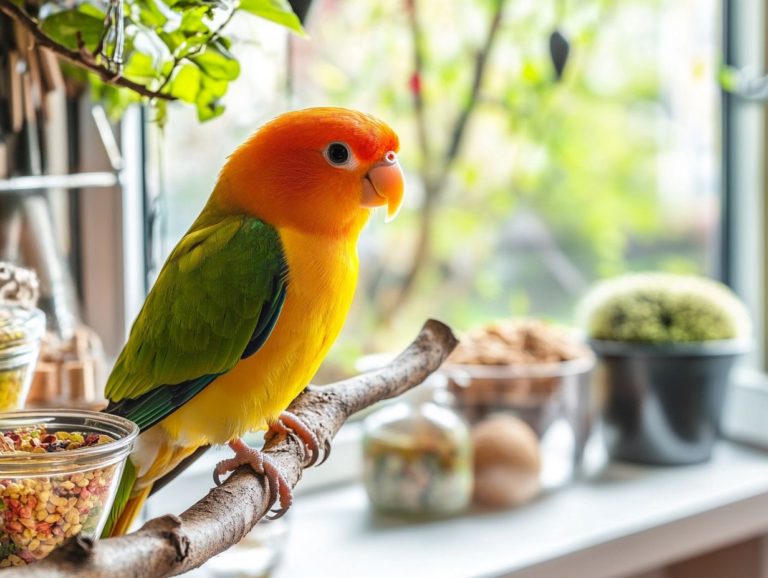How to Create a Bird-Friendly Backyard?
Creating a bird-friendly backyard isn’t merely a rewarding pastime; it’s an exciting adventure that supports our precious wildlife and contributes to the ecosystem.
By selecting the right plants and offering essential food and water sources, you can invite a delightful variety of bird species into your outdoor sanctuary.
Fostering a safe environment is key. Incorporating features like nesting boxes and bird baths will elevate the habitat you cultivate.
This guide will provide you with practical steps to transform your yard into a haven for birds, enriching your connection with nature along the way.
Contents
- Key Takeaways:
- Choosing the Right Plants
- Providing Food and Water
- Creating a Safe Environment
- Additional Features to Consider
- Maintaining Your Bird-Friendly Backyard
- Frequently Asked Questions
- 1. What are the benefits of creating a bird-friendly backyard?
- 2. How can I attract birds to my backyard?
- 3. Which plants will attract the most birds to my backyard?
- 4. Do I need to use pesticides in my bird-friendly backyard?
- 5. How can I make my backyard safer for birds?
- 6. Are there any resources available for creating a bird-friendly backyard?
Key Takeaways:
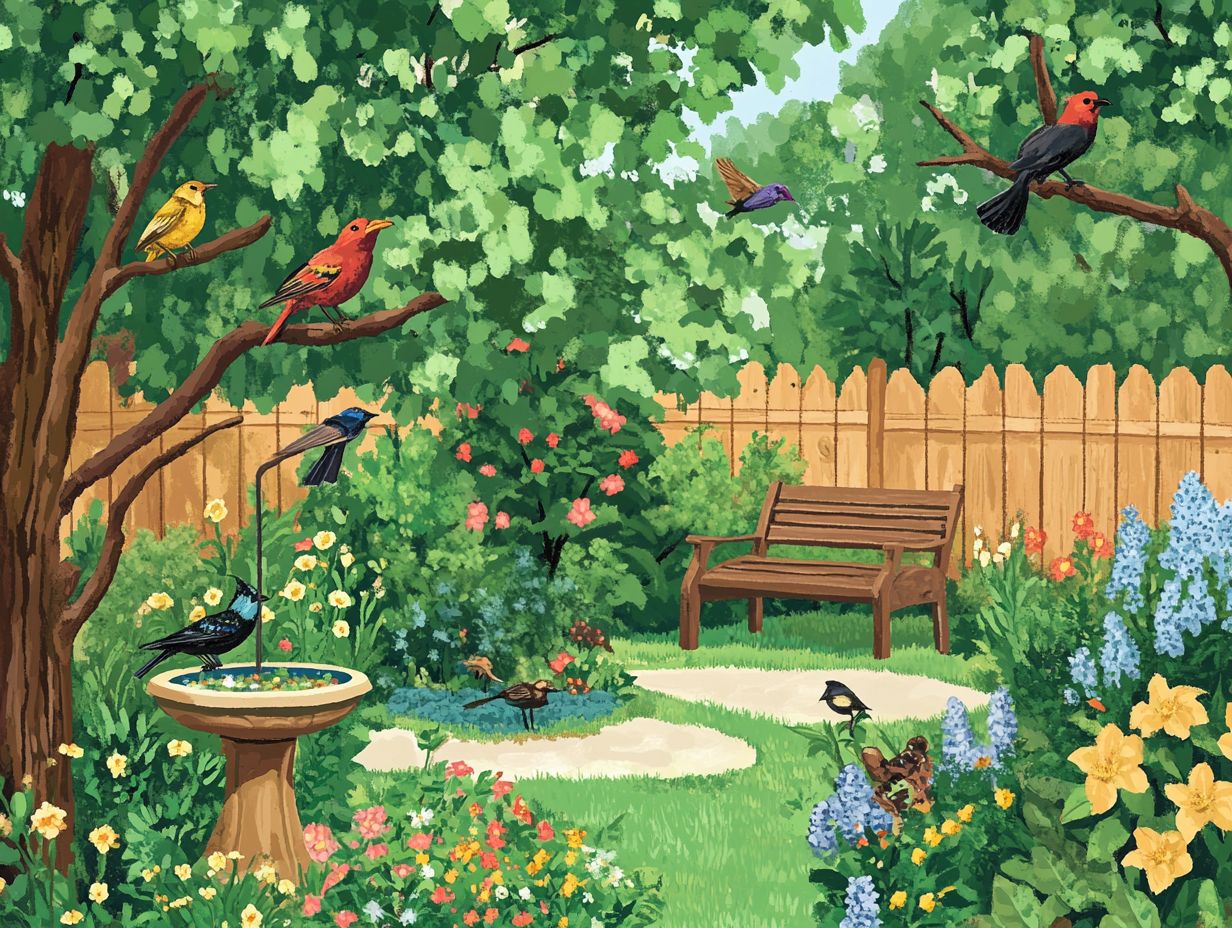
- Creating a bird-friendly backyard benefits both birds and humans by providing a welcoming backyard habitat and enhancing the beauty of your outdoor space.
- Choosing native plants and providing a variety of food and water sources are key in attracting different types of birds to your backyard.
- Prevent bird collisions and predators by implementing safe design features, such as placing feeders and water sources near trees and using decals on windows.
Why Create a Bird-Friendly Backyard?
Creating a bird-friendly backyard is essential, not just for conserving various bird species but also for enhancing your well-being. By learning how to create a bird-friendly home, you promote a variety of plant and animal life, making your outdoor spaces more enjoyable and alive.
This initiative helps address concerns like habitat loss and climate change, which pose significant threats to local bird populations and the insect populations they rely on. By focusing on native plants and incorporating bird-friendly features, you can create crucial food sources and nesting sites for vibrant wildlife.
Not only will this attract birds and pollinators, but it will also serve as an opportunity to educate your community about the importance of conservation efforts.
Benefits for Birds and Humans
The benefits of cultivating a bird-friendly backyard extend well beyond the mere delight of observing beautiful bird species. They contribute to vibrant ecosystems, support essential pollinators, and elevate the overall quality of life for everyone in the area, enhancing their connection with wildlife.
By designing spaces that invite various avian species, you are not only nurturing local ecosystems but also encouraging the presence of vital pollinators that enhance the growth of your gardens and native plants. Research indicates that yards boasting diverse bird populations can boost local biodiversity by up to 15%, positively impacting the flora and fauna upon which we all depend.
Engaging with nature in this manner has been shown to improve mental well-being, with a remarkable 70% of participants in community gardening programs noting reduced stress levels.
Through collaborative conservation efforts, neighborhoods come together, sharing knowledge and resources. This not only strengthens community ties but also nurtures a culture of stewardship and appreciation for the environment, making the effort all the more rewarding.
Choosing the Right Plants
Selecting the right plants is essential for creating a thriving bird-friendly backyard. By opting for native plants, you not only support local wildlife but also reduce maintenance efforts compared to invasive species.
This choice fosters a vibrant and flourishing ecosystem, allowing nature to thrive with minimal intervention on your part.
Native vs. Non-Native Species
Understanding the distinctions between native and non-native species is crucial as you create a bird-friendly habitat. Native plants provide the right food sources and nesting sites that local bird populations rely on for survival.
When non-native species make their entrance into an ecosystem, they can set the stage for situations where animals depend on the wrong food sources. This can lead to a reliance on unsuitable food sources and habitats, throwing the balance of local ecosystems into disarray and adversely impacting the insects and birds that depend on specific native plants.
As non-native species spread, they frequently outcompete indigenous flora, causing a decline in biodiversity. Therefore, prioritizing native plants is essential not just for supporting wildlife, but also for maintaining the intricate web of life that sustains species diversity and ecological resilience.
Start transforming your yard today and watch your local bird population flourish!
Attracting Different Types of Birds
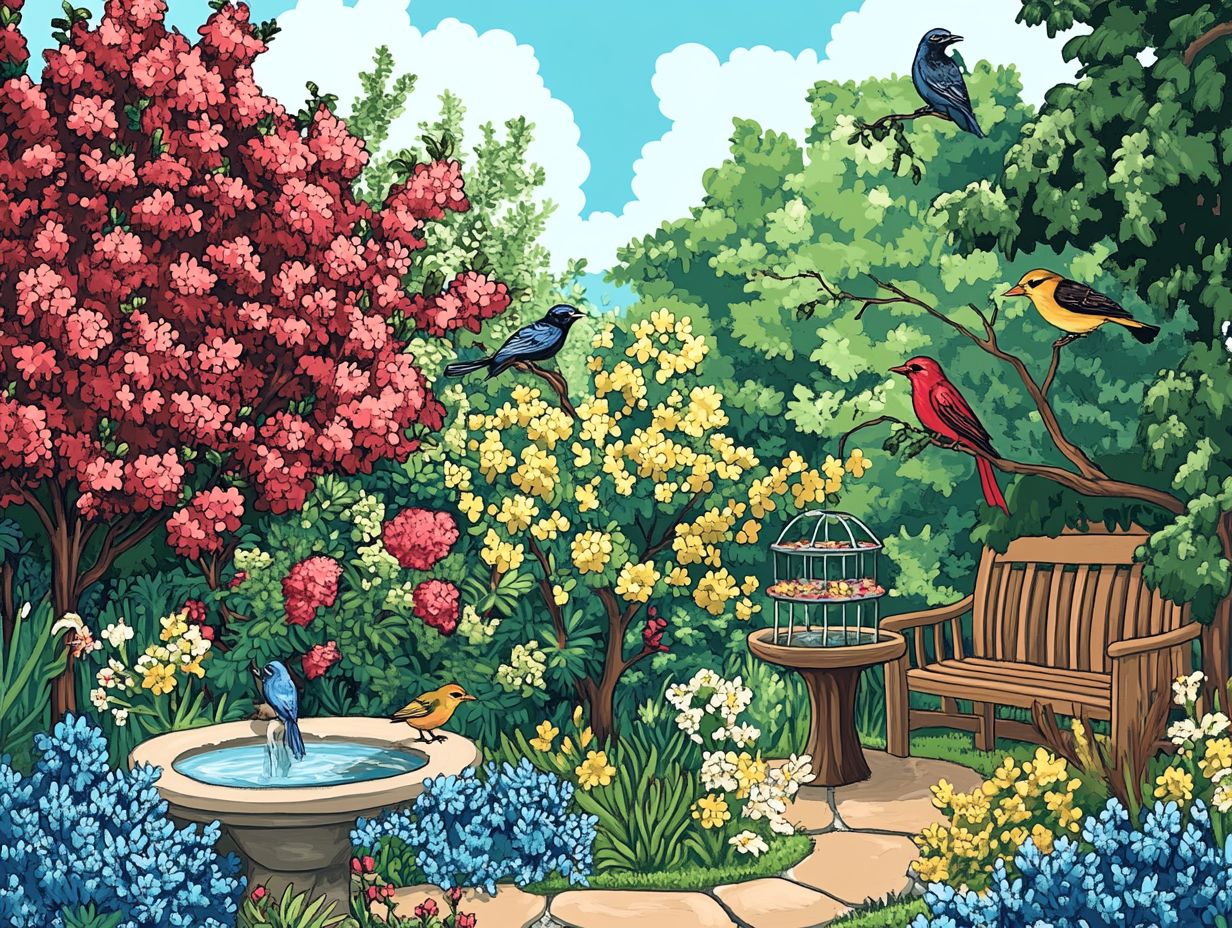
To attract a variety of bird species, it s essential to understand their preferences and provide a range of food sources that cater to different diets throughout the seasons.
In the spring, consider planting nectar-rich flowers such as salvia and bee balm. These flowers have sweet liquid that attracts hummingbirds eager for a sugary snack.
During the summer months, sunflowers and coneflowers become your allies, offering seeds that attract finches and other seed-eating birds.
As autumn approaches, think about incorporating plants like asters and goldenrod. These provide late-season nectar for pollinators and seeds for birds preparing for winter.
In winter, evergreens like holly serve as a source of berries, attracting mockingbirds and other fruit-eaters while offering crucial shelter.
By thoughtfully selecting a range of plants, you can create a thriving habitat that supports various birds year-round.
Providing Food and Water
Providing ample food sources and fresh water is essential for attracting birds to your backyard. This creates a sanctuary for them and supports pollinators.
By cultivating an inviting environment, you contribute to the well-being of local wildlife while enjoying the vibrant activity of nature right outside your door.
Types of Bird Feeders and Water Sources
There are various types of bird feeders designed to attract specific species. Options include platform feeders, tube feeders, and suet feeders. Each offers unique food sources for different birds.
Rotate the types of food you provide throughout the seasons to invite a delightful array of feathered visitors to your yard. For instance, during winter, high-energy suet is essential for certain birds, while seed blends might be more appealing in the spring and summer.
Regular cleaning and maintenance of your feeders are crucial to preventing mold and disease. A simple vinegar solution works well. Installing bird baths also provides hydration and enhances your overall birdwatching experience.
Add pebbles or stones to the bath to create a shallow area where smaller birds feel secure, encouraging them to visit more frequently.
Creating a Safe Environment
Creating a safe haven for birds in your backyard requires more than just offering food and water. Consider incorporating suitable nesting structures and minimizing threats from predators and collisions.
This approach fosters a welcoming environment where these beautiful creatures can thrive.
Preventing Bird Collisions and Predators
To protect birds from collisions and predators, adopt wildlife-friendly practices and create areas where birds can escape dangers.
Enhance urban spaces by using window decals that are easily visible to birds, helping them navigate safely. You can also use netting as an effective barrier around high-risk areas.
Managing local predator populations while keeping the ecosystem balanced requires strategies like enhancing habitats for smaller birds and providing them with safe havens.
By combining these approaches, you shield bird species from immediate threats and foster sustainable coexistence within their environments.
Additional Features to Consider
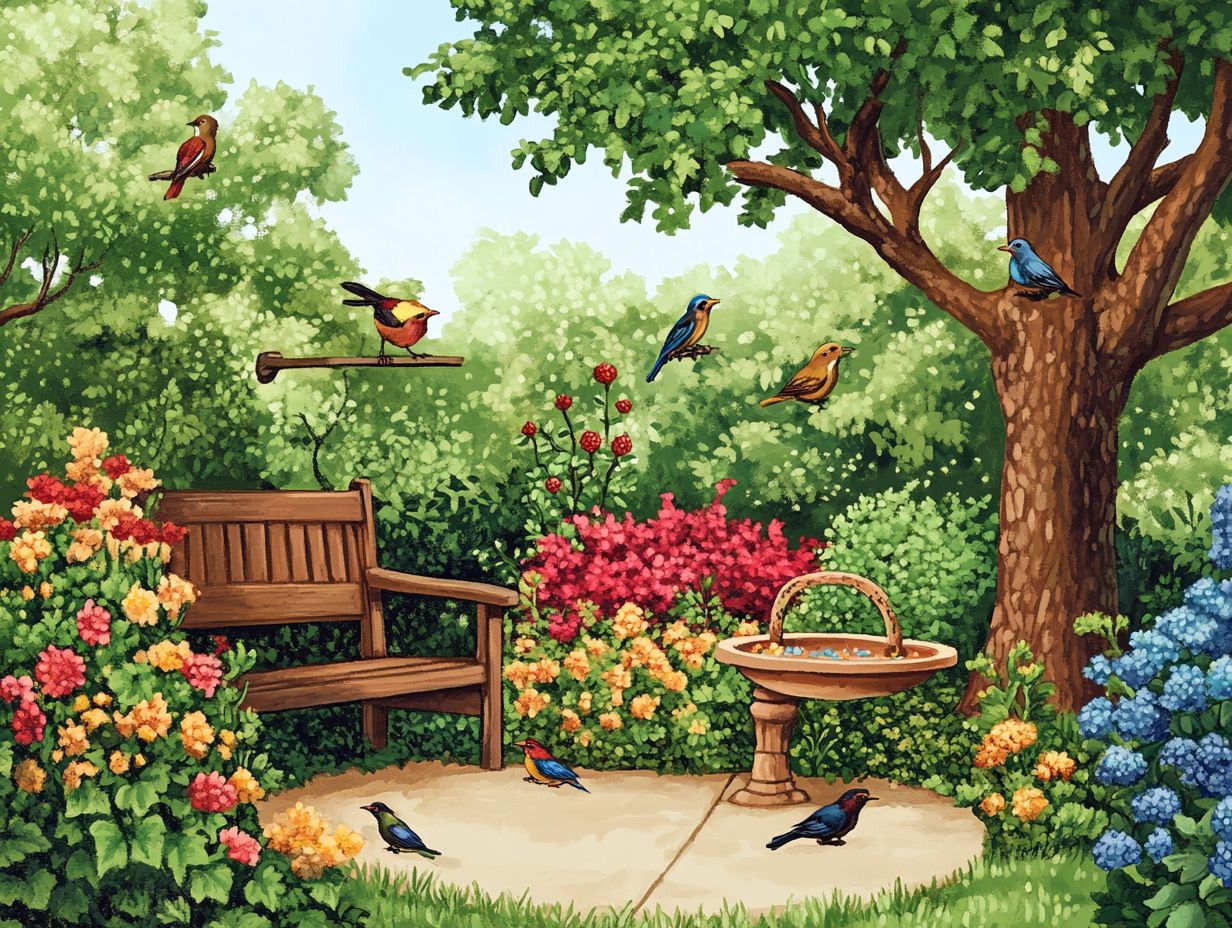
Incorporating features like nesting boxes and bird baths alongside your plants significantly enhances your backyard as an inviting bird habitat.
These enhancements encourage nesting and feeding behaviors among various bird species, transforming your outdoor space into a vibrant sanctuary for wildlife.
Nesting Boxes and Bird Baths
Nesting boxes and bird baths are essential parts of a bird-friendly backyard. They provide nesting sites and water sources that attract various bird species year-round, enhancing your outdoor spaces.
By carefully constructing or installing these features, you can transform your outdoor space into a lively environment. Make sure to position nesting boxes out of direct sunlight and provide shelter from harsh weather this is essential for the birds’ comfort and safety.
For bird baths, choose shallow designs with gently sloping edges to accommodate different species. Regular maintenance, such as cleaning bird baths and checking nesting boxes for pests, helps attract more birds and encourages a flourishing avian community.
A diverse mix of birdlife beautifies your environment and plays a significant role in helping plants grow by spreading seeds and controlling pests, underscoring the value of these thoughtful additions.
Maintaining Your Bird-Friendly Backyard
Maintaining a bird-friendly backyard is an ongoing commitment that requires your regular care and attention. Make sure food sources are always available to keep birds happy and habitat conditions optimal throughout the seasons.
This dedication enriches your outdoor space and fosters a thriving ecosystem right in your backyard.
Tips for Long-Term Success
Achieving long-term success in creating a bird-friendly backyard requires consistent effort, active community involvement, and an understanding of the evolving needs of bird species over time.
To enhance your efforts, engage with local conservation groups; they can offer invaluable insights into the specific requirements of the birds in your area. Participating in community initiatives and workshops sharpens your knowledge and nurtures camaraderie among fellow bird enthusiasts.
Cultivating native plants that provide food and shelter can transform your backyard into a haven for various bird species, especially as their migratory patterns shift. Staying informed about local conservation initiatives ensures that your gardening practices align with broader environmental goals, significantly contributing to the sustainability of bird populations for generations to come.
Frequently Asked Questions
1. What are the benefits of creating a bird-friendly backyard?
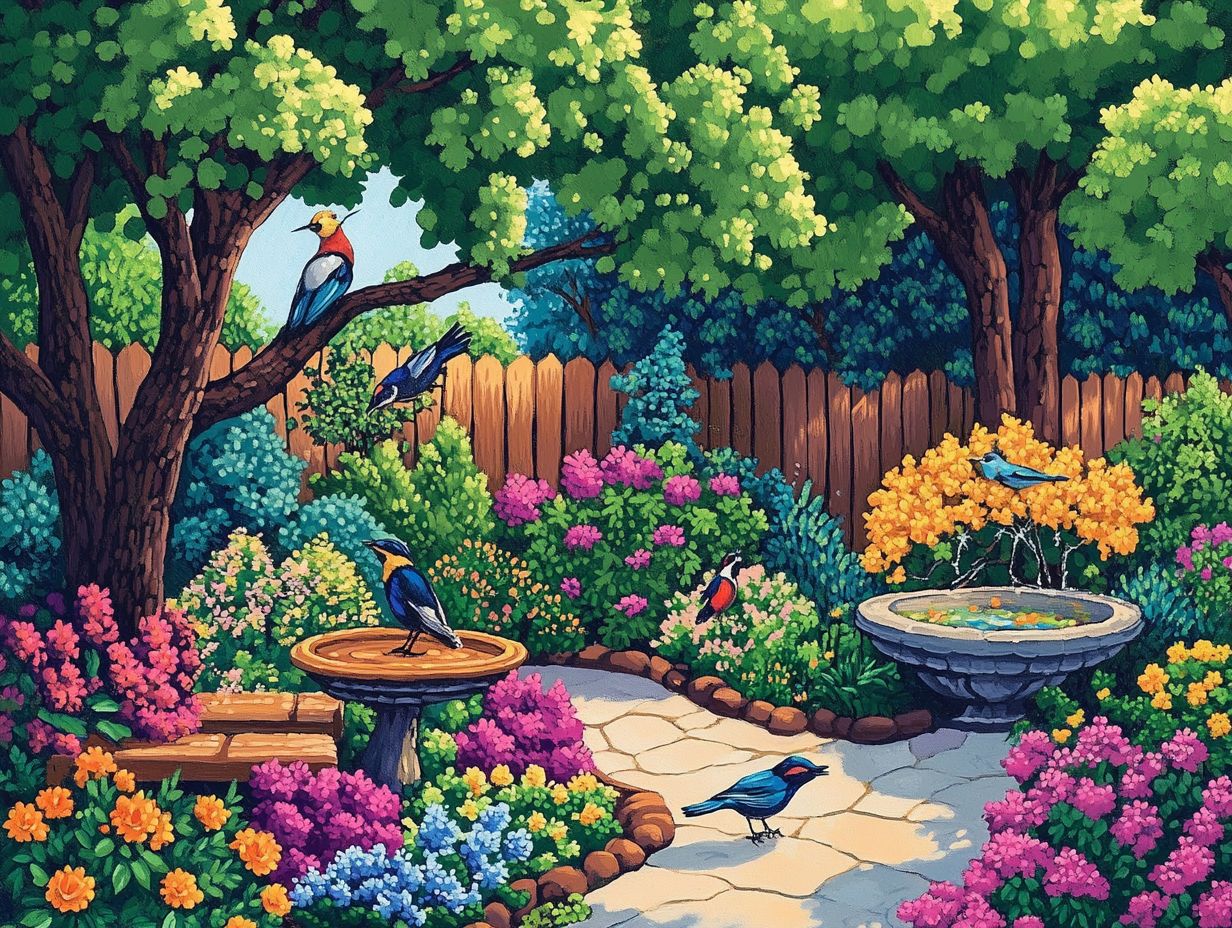
Creating a bird-friendly backyard brings joy and beauty! It also provides important benefits to local bird populations and the environment. By learning how to create a bird-friendly garden, you can help birds control insect populations, pollinate plants, and spread seeds, adding beauty and biodiversity to your backyard.
2. How can I attract birds to my backyard?
There are several simple ways to attract birds to your backyard. Provide a water source, offer a variety of bird feeders and food types, and incorporate native plants and trees that provide shelter and food.
3. Which plants will attract the most birds to my backyard?
Native plants are the best choice for a bird-friendly backyard, as they provide natural food sources and shelter for local bird species. They also require less maintenance and are better adapted to the local climate.
4. Do I need to use pesticides in my bird-friendly backyard?
No, avoid using pesticides as they can harm birds and other wildlife. Instead, consider natural pest control methods or choose bird-friendly plants that are less susceptible to pests.
5. How can I make my backyard safer for birds?
To make your backyard safer for birds, minimize potential hazards such as windows, outdoor cats, and toxic plants. Providing shelter and nesting boxes can help protect them from predators.
6. Are there any resources available for creating a bird-friendly backyard?
Yes, many resources are available, such as birding guides, online forums, and local birding clubs. You can also contact your local Audubon Society or wildlife center for tips and advice specific to your area.
Start your bird-friendly journey today your local birds will thank you!
